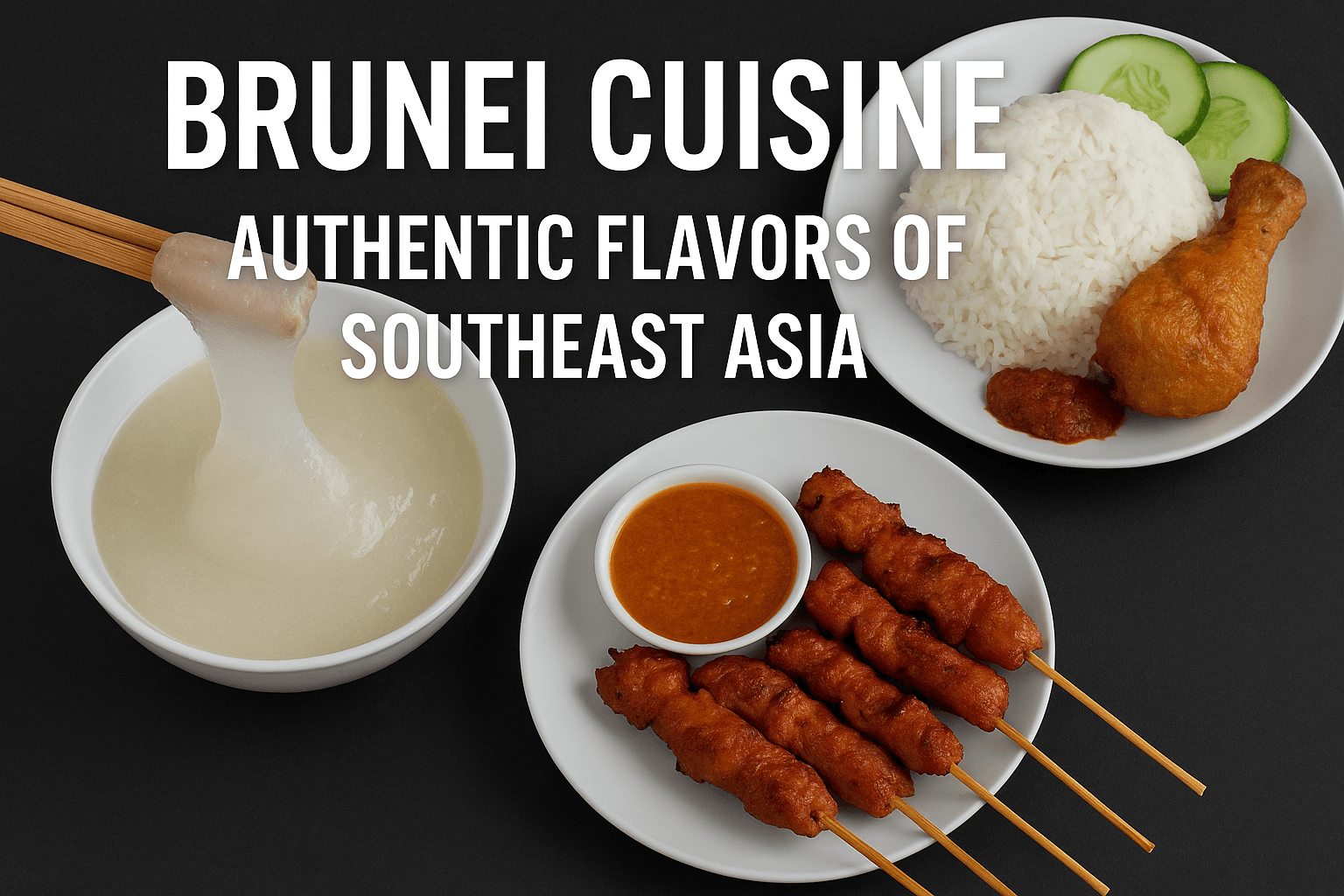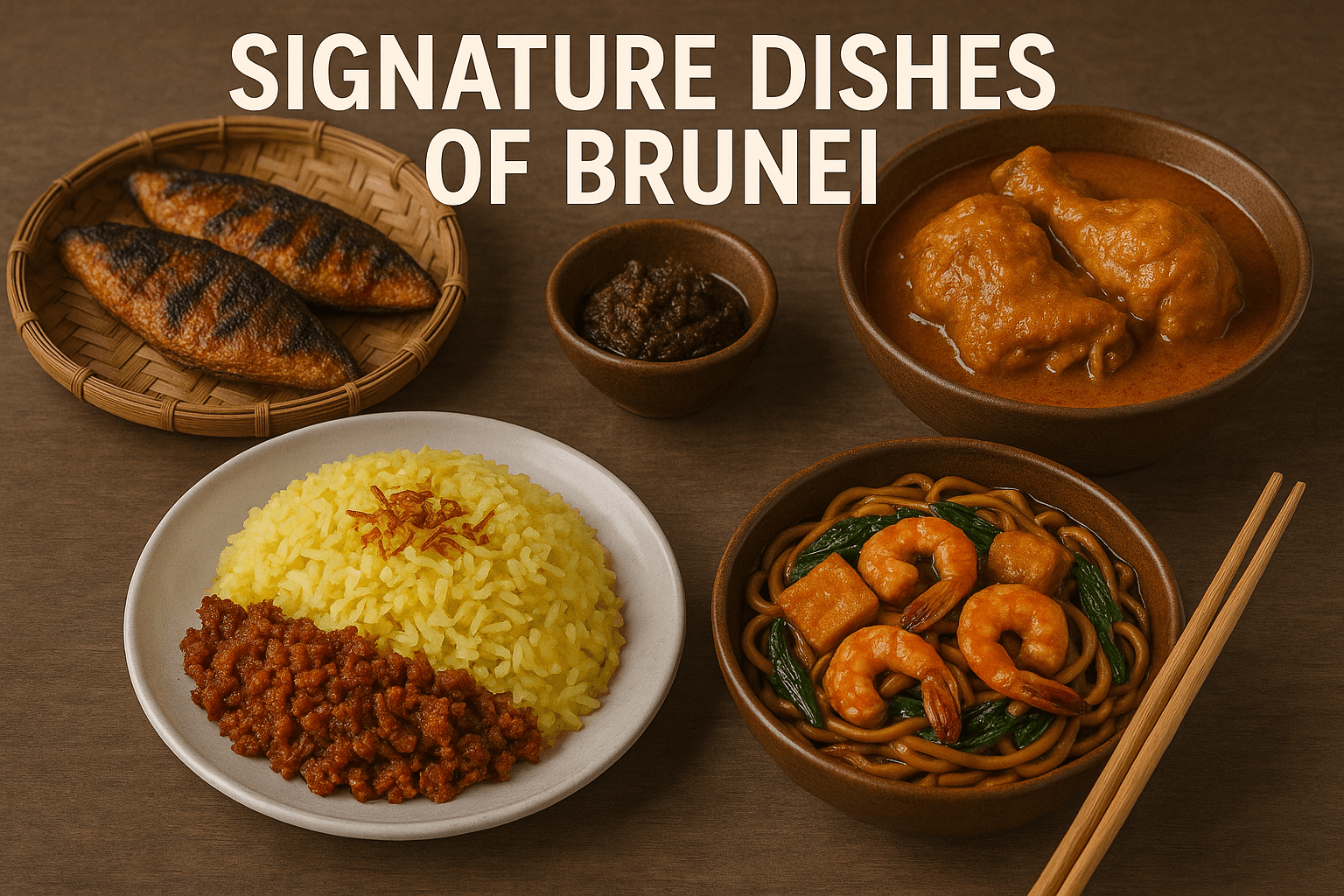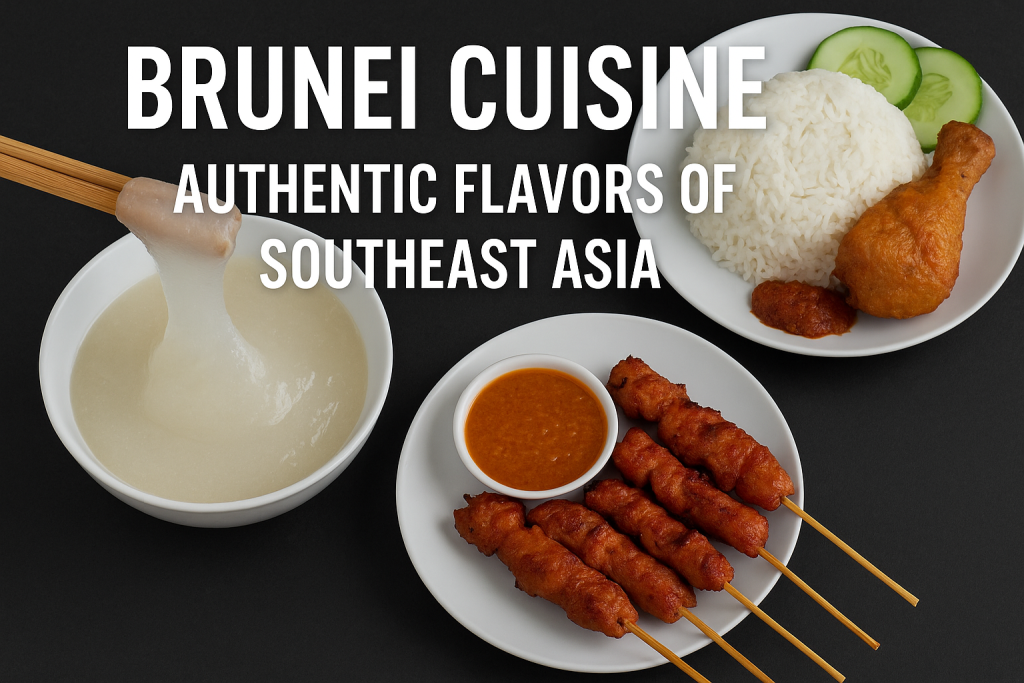Brunei Cuisine: Authentic Flavors of Southeast Asia reflects a remarkable culinary heritage shaped by geography, trade, religion, and multicultural influences. Situated on the island of Borneo, Brunei shares borders with Malaysia and proximity to Indonesia and the Philippines.
This small but culturally rich nation has developed a distinctive food culture that integrates Malay traditions, Islamic dietary practices, Chinese influences, and maritime ingredients. Exploring Brunei cuisine is not only about tasting delicious dishes but also understanding the country’s identity, history, and its role in the cultural mosaic of Southeast Asia.
This article offers a comprehensive guide to Brunei Cuisine: Authentic Flavors of Southeast Asia, covering traditional dishes, ingredients, cooking techniques, cultural significance, and its connection to the broader Southeast Asian culinary scene.

Historical Roots of Brunei Cuisine
The story of Brunei Cuisine: Authentic Flavors of Southeast Asia is deeply connected to the kingdom’s history. Brunei was once a powerful sultanate engaged in maritime trade, exchanging spices, rice, seafood, and other goods with traders from China, India, and the Middle East. These exchanges brought new flavors and techniques that shaped the foundations of the cuisine.
Malay Heritage
At the core lies the Malay food tradition: rice as the staple, coconut milk as a base for curries, and chili pastes for depth. Many dishes resemble those of neighboring Malaysia and Indonesia, but Brunei adds distinctive touches that make them unique.
Islamic Influence
As an Islamic nation, Brunei adheres to halal principles, which shape the types of meat used, methods of preparation, and overall food culture. Pork is absent, while beef, chicken, lamb, and seafood are central to everyday meals.
Chinese and Indian Contributions
Centuries of migration and commerce introduced Chinese noodles, soy sauces, stir frying, and Indian spices like turmeric and cardamom. These influences remain embedded in modern Brunei cooking.
Core Ingredients in Brunei Cuisine
The authenticity of Brunei Cuisine: Authentic Flavors of Southeast Asia lies in the balance of indigenous and imported ingredients.
Rice – Steamed rice and glutinous rice form the heart of daily meals. Popular variations include nasi lemak and nasi katok.
Seafood – The coastal geography ensures abundant fish, prawns, and crabs. Dishes like udang masak lemak (prawns in coconut milk) showcase this richness.
Coconut – Used in milk, cream, and grated form for both savory and sweet dishes.
Spices and Herbs – Lemongrass, ginger, turmeric, galangal, chilies, and pandan leaves provide aroma and depth.
Halal Meats – Chicken and beef are often marinated with spices and grilled or stewed.
Sauces and Condiments – Sambal, soy sauce, and belacan (shrimp paste) define the boldness of flavors.

Signature Dishes of Brunei Cuisine
When speaking of Brunei Cuisine: Authentic Flavors of Southeast Asia, several iconic dishes highlight the essence of the nation’s palate.
Ambuyat
Ambuyat is considered the national dish. Made from sago starch, it forms a sticky, glue like texture eaten with bamboo sticks called chandas. Dipped into sauces like binjai (a sour fruit sauce) or chili, ambuyat demonstrates how indigenous resources are transformed into culinary heritage.
Nasi Katok
A beloved street food, nasi katok is a simple combination of white rice, fried chicken, and sambal. Its affordability and flavor have made it a daily staple for many Bruneians.
Satay
Skewered and grilled meats marinated in spices, served with peanut sauce. Satay in Brunei emphasizes freshness and the halal preparation process.
Beef Rendang
Slow cooked beef with coconut milk and spices, a dish that connects Brunei to the broader Malay world. Its depth of flavor represents ceremonial and festive meals.
Ayam Penyet
Fried chicken smashed lightly and served with sambal, cucumber, and rice. This dish demonstrates regional exchanges between Brunei and Indonesia.
Soto Brunei
A clear noodle soup made with beef or chicken broth, spiced with coriander, star anise, and garlic. Garnished with lime, sambal, and fresh herbs.
Street Food Culture in Brunei
The vibrancy of Brunei Cuisine: Authentic Flavors of Southeast Asia comes alive in its street food markets, especially at Gadong Night Market. Here, locals and visitors enjoy grilled seafood, satay, kueh (traditional cakes), and refreshing drinks. Street food represents the informal yet authentic side of Brunei cuisine, where flavors are bold and community gatherings are central.
Desserts and Sweets
No discussion of Brunei Cuisine: Authentic Flavors of Southeast Asia is complete without desserts. Sweet treats are rooted in Malay traditions, using rice flour, coconut milk, and palm sugar.
Kueh – Colorful bite sized cakes, steamed or fried, such as kueh lapis.
Cendol – A cold dessert with pandan jelly, coconut milk, and palm sugar syrup.
Kuih cincin – Flower shaped cookies fried until crispy, symbolizing festive occasions.
Tapai – Fermented glutinous rice wrapped in leaves, highlighting ancient techniques.
Beverages in Brunei Cuisine
Brunei beverages complement meals with refreshing and often sweet flavors. Teh tarik (pulled tea), kopi (local coffee), and bandung (rose syrup with milk) are popular. Coconut water and sugarcane juice are common street drinks.
Cultural Role of Food
Brunei Cuisine: Authentic Flavors of Southeast Asia goes beyond sustenance. It embodies hospitality, religious observance, and social bonding. Sharing food during Ramadan, weddings, or royal events symbolizes unity. Communal eating and festive dishes reflect collective identity.
Brunei Cuisine in the Context of Southeast Asia
Although Brunei is a small nation, its food has a place in the larger Southeast Asian culinary tapestry. The use of coconut, chili, rice, and seafood links Brunei cuisine to Malaysia, Indonesia, and the Philippines, while Chinese noodle dishes and Indian curries provide diversity. Brunei’s distinctiveness lies in its Islamic food culture and unique dishes like ambuyat.
Modern Developments and Global Presence
With increasing globalization, Brunei Cuisine: Authentic Flavors of Southeast Asia is gaining attention internationally. Restaurants abroad highlight Bruneian specialties, while food festivals in Southeast Asia feature Brunei as part of the shared culinary heritage. Digital platforms, food blogs, and travel guides amplify its reach to global food lovers.
Health and Nutrition Aspects
Traditional Brunei Cuisine: Authentic Flavors of Southeast Asia emphasizes natural ingredients, balanced meals, and communal dining. While coconut milk and fried foods contribute richness, the use of herbs, spices, and fresh seafood adds nutritional benefits. Modern Bruneians balance tradition with contemporary health trends, adapting dishes to lighter cooking methods.
Future of Brunei Cuisine
As Brunei modernizes, its cuisine faces challenges and opportunities. Urbanization, international fast food, and changing lifestyles may alter traditional eating habits. However, efforts to preserve recipes, promote halal tourism, and integrate Brunei cuisine into the broader Southeast Asian identity ensure that authenticity remains intact.
Conclusion
Brunei Cuisine: Authentic Flavors of Southeast Asia represents a journey through history, culture, and taste. From the iconic ambuyat to vibrant street food markets, from festive rendang to sweet kueh, Brunei offers a rich culinary identity that resonates with its people and intrigues international visitors. Exploring this cuisine means experiencing the authentic flavors of Southeast Asia in their most intimate and hospitable form.
Brunei’s culinary landscape proves that even a small nation can present a big voice in the conversation of global food culture. By preserving tradition, embracing diversity, and celebrating community, Brunei Cuisine: Authentic Flavors of Southeast Asia continues to stand as a proud testament to heritage and flavor.

